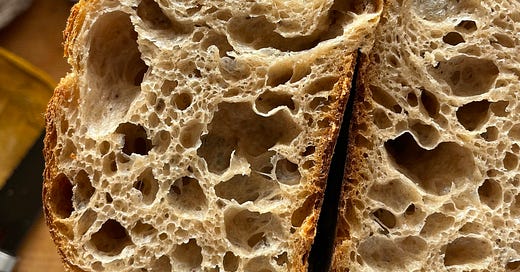When I started my journey in sourdough baking flours were the biggest mystery to me. While knowing they are the main ingredient of bread and hence the main carrier of taste I didn’t know anything about the difference of their performance and naively thought that most flours would perform similarly and if they contain gluten will be able to somehow produce a stable dough. That naive thought only lasted until I made my first rye bread and almost cried because this sticky mess would not form any gluten bonds and be a sad little cake batter for most of the process. I then went on to study flours and talked to people about their experience with them. I learned about protein, water intake and the balance of extensibility and elasticity. I also learned that these variables have different meanings for all grains.
South Africa where I learned how to bake hasn’t much variety in grains and wheat and a little rye were the common grains available. It was only back in Germany when I learned about spelt. Spelt is a very old heirloom grain mostly popular in Central Europe, especially in Germany and Poland. It’s available in most parts of the world nowadays but is somewhat of a specialty grain that is mostly used as an addition to dough, but rarely on it’s own. It’s taste is a little sweeter and nuttier as wheat and it’s commonly known for better health benefits and nutrition values.
Through my research and the spelt bread I found in bakeries I wasn’t a big fan of it though. I don’t know why but everyone I talked to and most bakeries I went to would sell these dense, mostly baked in tins spelt breads that were neither airy nor looked very appealing to me. I knew that spelt would produce a very extensible dough and I only ever added a little to strong wheat flours to increase extensibility. People and books told me that it’s hard to build a strong gluten network with spelt, that it bakes very dry and you’d need a soaker to get it to last long. They also told me that it’s hard to get a soft and open crumb with it and because the gluten network can’t get very elastic so going for a tin loaf is the better choice. Based on these experiences and learnings I put spelt away, it just didn’t seem like a flour I’d really want to use as a main flour or dive too deep into as I love my open and soft crumbs and would prefer to go to rye for taste and denser crumbs.
It was earlier this year on my trip in Tel Aviv that spelt appeared back on my radar. It was everywhere there and when I brought some home and tried to make a loaf with it I failed miserably. Because of what I saw people make with it though and finally appreciating the taste of it the challenge was accepted…
Keep reading with a 7-day free trial
Subscribe to A Sour Stories to keep reading this post and get 7 days of free access to the full post archives.





